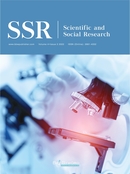Research Status of Motor Quotient and Its Evaluation System
Abstract
By combing relevant research on the development status of motor quotient and its evaluation system at home and abroad, this paper expounds and clarifies the future research direction of motor quotient as well as constructs a basic framework of motor quotient concept classification and evaluation-application system. Research found that first, the research on motor quotient abroad started earlier and has rich evaluation means, mainly focusing on the clinical diagnosis of preschool children’s development and the evaluation of motor development, but there is little discussion on the concept of motor quotient, only involving the discussion on sports quality and kinesthetic intelligence; applied research is mainly reflected in the fields of physical education and medical clinic. Second, there are many discussions on the concept and connotation of motor quotient in China. The research on evaluation system is gradually enriched, but most of it is used in the field of education, while that of practical application is almost bare. Third, the future research direction should focus on teenagers, carry out research from a multi-disciplinary perspective, broaden the research field, and enrich practical application.
References
McCloy CH, 1934, The Measurement of General Motor Capacity and General Motor Ability. Research Quarterly American Physical Education Association, 5(sup1): 46-61.
Capute AJ, Shapiro BK, 1985, The Motor Quotient. A Method for the Early Detection of Motor Delay. American Journal of Diseases of Children (1960), 139(9): 940-942.
Emck C, Bosscher RJ, Wieringen PCV, et al., 2011, Gross Motor Performance and Physical Fitness in Children with Psychiatric Disorders. Developmental Medicine & Child Neurology, 53(2): 104-105.
Wang Z, Zhang Y, 2014, Motor Quotient – An Important Support for the All-round Development of Mankind. Journal of Physical Education, 21(04): 13-16.
Gardner H, 1999, Multiple Intelligence [Shen Z, Trans.], Xinhua Publishing House, Beijing.
Jiang L, 2016, Preliminary Development of Motor Quotient Scale for 5-6 Years Old Children, Nanjing Sport Institute.
Hu H, Wang Z, 2016, Motor Quotient: Motion Ensures the Permanence of the Life. Journal of Nanjing University of Science and Technology (Social Sciences), 29(02): 33-38.
Jenny JH, 1959, The M.Q. is as Important as the I.Q. American Physical Education Review, 1959(4): 23.
Wang H, Zhang Y, 2017, New Discussion on the Value of Motor Quotient in the Context of “Internet +”. Journal of Nanjing University of Science and Technology (Social Sciences), 30(06): 39-42.
Zhang H, Li H, Cui C, et al., 2016, Construction of Dynamic Quotient Test Scale, Motor Quotient Formula and Evaluation Standard – A Case Study on Motor Quotient Evaluation System for Children Aged 5-6. Journal of Wuhan Institute of Physical Education, 50(02): 69-74.
Chang J, 2016, Theoretical Tracing and Framework Construction of Adolescent Motor Quotient Research. Journal of Nanjing University of Science and Technology (Social Sciences), 29(01): 35-39.
Zhang H, Wang Z, 2021, Compilation of Motor Quotient (7-12 years old) Scale – Based on Analysis of Jiangsu, Zhejiang, Shanghai and Shandong Experimental Data. Journal of Nanjing University of Science and Technology (Social Sciences), 34(01): 62-71.
Fransen J, Pion J, Vandendriessche J, et al., 2012, Differences in Physical Fitness and Gross Motor Coordination in Boys Aged 6-12 Years Specializing in One Versus Sampling More Than One Sport. J Sports Sci, 30(4): 379-386.
Ye A, Yan S, Huang K, et al., 2019, Maternal Intelligence Quotient and Motor Development in Early Childhood: The Mediating Role of Mother’s Education. Journal of Paediatrics and Child Health, 55(1): 87-94.

